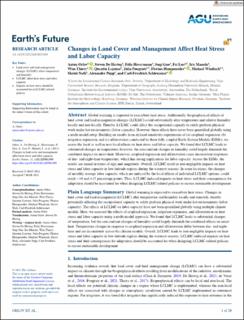| dc.contributor.author | Orlov, Anton | |
| dc.contributor.author | De Hertog, Steven | |
| dc.contributor.author | Havermann, Felix | |
| dc.contributor.author | Guo, Suqi | |
| dc.contributor.author | Luo, Fei | |
| dc.contributor.author | Manola, Iris | |
| dc.contributor.author | Thiery, Wim | |
| dc.contributor.author | Lejeune, Quentin | |
| dc.contributor.author | Pongratz, Julia | |
| dc.contributor.author | Humpenöder, Florian | |
| dc.contributor.author | Windisch, Michael | |
| dc.contributor.author | Nath, Shruti | |
| dc.contributor.author | Popp, Alexander | |
| dc.contributor.author | Schleussner, Carl-Friedrich | |
| dc.date.accessioned | 2024-02-22T12:18:22Z | |
| dc.date.available | 2024-02-22T12:18:22Z | |
| dc.date.created | 2023-05-09T09:43:34Z | |
| dc.date.issued | 2023 | |
| dc.identifier.citation | Earth's Future. 2023, 11 (3), . | en_US |
| dc.identifier.issn | 2328-4277 | |
| dc.identifier.uri | https://hdl.handle.net/11250/3119351 | |
| dc.description.abstract | Global warming is expected to exacerbate heat stress. Additionally, biogeophysical effects of land cover and land management changes (LCLMC) could substantially alter temperature and relative humidity locally and non-locally. Thereby, LCLMC could affect the occupational capacity to safely perform physical work under hot environments (labor capacity). However, these effects have never been quantified globally using a multi-model setup. Building on results from stylized sensitivity experiments of (a) cropland expansion, (b) irrigation expansion, and (c) afforestation conducted by three fully coupled Earth System Models (ESMs), we assess the local as well as non-local effects on heat stress and labor capacity. We found that LCLMC leads to substantial changes in temperature; however, the concomitant changes in humidity could largely diminish the combined impact on moist heat. Moreover, cropland expansion and afforestation cause inconsistent responses of day- and night-time temperature, which has strong implications for labor capacity. Across the ESMs, the results are mixed in terms of sign and magnitude. Overall, LCLMC result in non-negligible impacts on heat stress and labor capacity in low-latitude regions during the warmest seasons. In some locations, the changes of monthly average labor capacity, which are induced by the local effects of individual LCLMC options, could reach −14 and +15 percentage points. Thus, LCLMC-induced impacts on heat stress and their consequences for adaptation should be accounted for when designing LCLMC-related policies to ensure sustainable development. | en_US |
| dc.language.iso | eng | en_US |
| dc.publisher | AGU | en_US |
| dc.rights | Navngivelse-Ikkekommersiell 4.0 Internasjonal | * |
| dc.rights.uri | http://creativecommons.org/licenses/by-nc/4.0/deed.no | * |
| dc.title | Changes in Land Cover and Management Affect Heat Stress and Labor Capacity | en_US |
| dc.title.alternative | Changes in Land Cover and Management Affect Heat Stress and Labor Capacity | en_US |
| dc.type | Peer reviewed | en_US |
| dc.type | Journal article | en_US |
| dc.description.version | publishedVersion | en_US |
| dc.source.pagenumber | 0 | en_US |
| dc.source.volume | 11 | en_US |
| dc.source.journal | Earth's Future | en_US |
| dc.source.issue | 3 | en_US |
| dc.identifier.doi | 10.1029/2022EF002909 | |
| dc.identifier.cristin | 2146335 | |
| dc.relation.project | Norges forskningsråd: 300478 | en_US |
| cristin.ispublished | true | |
| cristin.fulltext | original | |
| cristin.qualitycode | 1 | |

